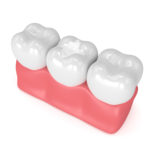
Family dentistry is a broad term that can best be used to describe the services which can be provided by that of a general dentist. This means that a general dentist has to be adept in treating and managing everyone from the uncooperative three year old to the semi-mobile octagenarian.
Fortunately, dentistry and it's method of prevention over the last few decades has begun to bear fruit. More people are keeping their teeth as they age and we are seeing fewer and fewer children with cavities. You can give credit to things like fluoridation, better regularity with dental care, and more awareness from parents for giving their children an early dental experience.
It is my sole belief that we are all good patients, but that bad experiences like toothaches can make anyone a dental phobic. If we are allowed to prevent these kind of events from occurring through regular dental care, one need never fear the horror stories so often told.
Family dentistry therefore is concerned with the prevention of decay through education and use of modern materials that strengthen and decrease your chances of "getting a cavity". But if you do get a cavity there are many good ways to fix your teeth. One important thing to remember is that you should be given options. There is not always just one way to fix something. There may be pros and cons to each method, but properly informed you can make the right decision.
Cleanings
Normal prophylaxis - this is what most people think of when they think of getting their teeth cleaned. This is the type of cleaning performed a majority of the time in our office. This is normally performed as a one appointment procedure in conjunction with a complete hard and soft tissue exam and may include x-rays if necessary.
Periodontal scaling - This method is used when your pocket readings are usually 5mm or greater in more than one region. It will at times require anesthesia and may require several appointments to ensure that a thorough job has been done. Each patient is examined thoroughly by our hygienist in an effort to tailor the necessary treatment for you.
Periodontal patients are screened via our new patient examination and it is determined early on whether or not you may be a candidate for said treatment. Each case is very individualistic.
-
Exam
- Our new patient exam is very thorough. As mentioned above, it is a screening process in which I can easily discern your dental needs and best direct you in achieving a goal of dental health. I look at all hard (tooth) tissues as well as extraoral and introral soft tissues. Also checked is your occlusion (bite) and jaw function.
Sealants

A sealant is a plastic coating that is placed within the deep anatomic pits and fissures that make up the top portion of a molar and in other areas that may be prone to decay. It works by not allowing bacteria and food particles to colonize these areas and produce acids which can ultimately lead to decay.
We usually place these on permanent teeth (molars and bicuspids - but can also place them on baby teeth as well.
The process is very simple and straightforward and requires no anesthesia.
Filling Types

Amalgam
This material has been used for over 150 years and for good reason. It is still a material that offers the best cost to benefit ratio of any material. It is best used in small to moderately sized fillings as it does not serve to strengthen the tooth, but merely fills the void created as a consequence of the decay. Their primary means of sealing the tooth is a result of oxidation of the silver (rust). This is why these fillings may be cold sensitive for a while - until the oxidation occurs. In recent times there has been much controversy regarding its' use. If you have any questions please feel free to discuss it with me. Dentistry is beginning to phase out metal based materials as the ceramics and composite materials become stronger and better. There is still the occasion to use amalgam, but we see such indications less and less.

Tooth Colored Fillings
There are two primary types of "white" fillings; the direct filled and the indirect filled. So what you say? What's the difference? Actually quite a bit. Let me explain.
Direct filled are the kind that you or someone you may know has been getting in the front teeth for some time now, but what has changed as of late is that they are now being increasingly used in the back teeth as well. Through continued research their strength and wear rate has increased dramatically so as to allow them for use in areas with moderate stress. What this means is that we can now place them in molars if they are kept small. These are done at one sitting.
Indirect fillings are done in a one appointment process in which your tooth is prepared very similarly to the direct filled version. A scan is then done using the CEREC Omnicam and is constructed in the office while you wait. The final restoration is much like a puzzle piece that then fits into the space prepared. Its' advantage is greater strength than the direct filled kind.
Both of these filling types are bonded to the tooth which means they become attached adhesively (like glue) and actually serve to strengthen your tooth. This is modern dentistry at its' finest.

Gold Fillings
This needs no introduction. Gold has been used as a dental filling material since the times of the Incas and Egyptians. It is noncorrosive, malleable and wears very similarly to natural tooth structure. Yet, ceramic restorations are becoming the treatment of choice for those situations that once were the province of gold. There are a few times that it becomes the treatment and material of choice. I will make that decision and offer you the proper options.


X-Rays
X-rays are our confirming tool used to diagnose everything from decay to bony abnormalities. We don't take x-rays everytime we see you, but take them based on need. Even if you haven't had a cavity in several years, there may be other undiagnosed problems that could be related to bone, teeth and gums. Note below that we use panoramic x-rays (left image) to determine the general appearance of your jaws and teeth. This also gives us a good image of wisdom teeth. The smaller x-ray (right image) demonstrates cavities and bone loss in greater detail than the panoramic x-ray. Digital x-rays have greatly reduced the amount of radiation to which you are exposed.

Laser Cavity Detection
Diagnodent: This technology is a non-invasive technology that allows us to accurately and repeatedly gauge the progress of a cavity. It enables us to catch these when very small thus preventing the need for a large restoration.

Sports Guards
Sports guards are advised for youngsters of all ages. If your loved ones play in any kind of contact sport or in cases where projectiles are present, a properly constructed guard can prevent injuries to the teeth or soft tissues.

Education
While we strive to do our very best in each and every phase of your treatment there remains one thing that stands out above the rest. It's the effectiveness with which we teach you to maintain your teeth for a lifetime. We want you to keep your teeth and what you carry home in knowledge from this office is all important. Without it the best dentistry is for naught. Remember that regular dental checkups are as important as the restorations we place and meticulous home care will ensure your good dental health between visits.
